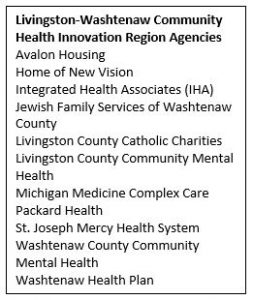 Community leaders came together on April 3 to discuss the WHI’s community-wide care coordination intervention for frequent Emergency Department (ED) users (aka, the SIM). Directors from the SIM’s 11 founding partners (hublets) and partner entities were invited to attend, and roughly two-dozen came out to participate in the conversation.
Community leaders came together on April 3 to discuss the WHI’s community-wide care coordination intervention for frequent Emergency Department (ED) users (aka, the SIM). Directors from the SIM’s 11 founding partners (hublets) and partner entities were invited to attend, and roughly two-dozen came out to participate in the conversation.
At tables of eight, patterned after the bimonthly quality improvement meetings that their staff attend, directors discussed what the intervention does; how it impacts participants, hublets, and the community; the limits of the intervention as it is currently structured; whether and how it integrates with partner agency practices; and how it could evolve with sustained and improved funding.
 They discussed some of the intervention’s best features, including the proactive identification of individuals who frequently use the ED and who might benefit from it; the contributions of community health workers; the improved relationships and communications that lead to more effective and efficient care coordination; and more.
They discussed some of the intervention’s best features, including the proactive identification of individuals who frequently use the ED and who might benefit from it; the contributions of community health workers; the improved relationships and communications that lead to more effective and efficient care coordination; and more.
On the positive side, hublet leaders had much to say about cross-learning and collaboration, expedited access to care, multidisciplinary contributions to participant-care, increased understanding of community resources, reduced duplication of services, better understanding of patient utilization, full assessment of participant needs, and improved knowledge of referral outcomes.
But they didn’t shy away from describing intervention limitations and challenges, including the limited capacity of case managers; the difficulty accessing affordable housing and substance use treatment services for participants; the challenges reaching and engaging individuals who might benefit from the intervention; the limited involvement from local Emergency Departments; the policies of participating agencies–such as office-based service delivery and narrowly defined eligibility criteria–that make it difficult to serve participants; the limited transportation options for preventive care; and dual-documentation requirements for each participant (which, one attendee said, came up no less than five times during the conversation).
 Still, said one hublet lead, “It does more than I ever thought it would do. The enhancements, relationships, efficiencies–I didn’t think we would get here.” Another, speaking about the intervention, said “One year ago, this list [of items to improve] would have been longer. Things are much better.”
Still, said one hublet lead, “It does more than I ever thought it would do. The enhancements, relationships, efficiencies–I didn’t think we would get here.” Another, speaking about the intervention, said “One year ago, this list [of items to improve] would have been longer. Things are much better.”
When talking about intervention improvements that could be made with outside funding, hublet leads spoke about the need for unrestricted funds to support transportation and other unaddressed individual needs; the need to expand community services in areas of scarcity including housing, social isolation, and substance use treatment; the hope to extend the intervention to new populations; the desire to develop enhanced community services in hot spot regions; and more.
At this time, intervention funding will expire in January 2020; however, efforts are being made to secure funding to continue the intervention–at least until the impact is better understood.
